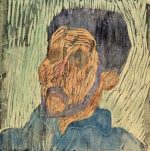“If it is to be, it is up to me”
William H. Johnson
William H. Johnson is an American painter and printmaker best known for his landscape and portrait paintings and prints. Johnson’s technique progressed from realism to expressionism to the powerful folk style that he is best recognized for. The Smithsonian American Art Museum has a large collection of his paintings, watercolours, and prints.
Early Life
- He grew up in South Carolina, where he learned to draw at an all-black school.
- He honed his skills by copying comic strips from the newspaper.
- He moved to New York to live with his uncle when he was 17 years old.
- He attended an art school in New York City. New York City’s National Academy of Design.
- Johnson was mentored by Professor Charles W. Hawthorne at the academy and given a job to help pay for his education.
5. His art teacher thought he had a lot of potential and encouraged him to apply for an art scholarship to Paris, which he did but did not receive. When this happened, his teacher raised $1,500 to enable Mr. Johnson to travel to Paris.
6. He travelled to France at the age of 26 and stayed in Europe for the next 12 years. He learned a lot about painting while he was there, but when he returned to America, he decided to concentrate his work on black people.
His career
7. Johnson studied modernism in France. Johnson used a number of media while he was a working artist, including woodcuts, oil, water colors, pen and ink, and serigraphy. He frequently expressed his work with whatever resources were on hand.
8. Johnson aimed to gain racial acceptability and a professional reputation abroad, much like the African American artist Henry O. Tanner.
9. His painting was influenced by well-known modern movements in Paris including expressionism and post-impressionism.
10. His artwork was influenced by Chaim Soutine and French artist Paul Cezanne (1839–1906). (Lithuanian, 1894-1943)
11. The young artist returned to New York after spending nearly two years in France, where he ran upon George Luks once more. As a result of Luks’ nomination for the prestigious Harmon Award and his encouragement, Johnson’s work gained recognition in the city’s art scene. Luks was impressed with Johnson’s artistic development.
12. Johnson visited his childhood home in America. Johnson began to capture Florence, South Carolina’s daily life using friends and family as his subjects.
13. The Johnsons continued to create art and travel extensively. After a trip to Tunisia, the Johnsons moved to Norway in 1935. Once again Johnson’s style changed.

14. During the Harlem Renaissance, Johnson was one of the most prominent painters of African-American life.
15. He spent most of his time in Europe, where Post-Impressionism and Expressionism influenced him.
Later Years
16. He was diagnosed with syphilis in 1947, which had affected both his mental and physical abilities. The U.S. Embassy in Oslo sent him back to New York as a citizen who was no longer regarded as mentally capable.
17. After 1955, he stopped painting, and on April 13, 1970, he passed away from pancreatic hemorrhage.
Recognition

18. His career nearly destroyed all of his artwork while he was unwell in 1956.
Instead, the Harmond Foundation received all of his efforts. This organization aids in the support of black artists.
19. Mr. Johnson donated 1,000 paintings, watercolours, and prints to the Smithsonian Institution.
20.. William H. Johnson has 9 works online.
21. There are 2,395 paintings online.
22. He liked bright bold colors, Colors of Africa.
23. his paintings focused on Blacks in the 1940s, friends and family
24. More than 1,000 Johnson paintings, watercolors, and prints were donated by the Harmon Foundation to the Smithsonian American Art Museum on April 19, 1967.
25. The Smithsonian American Art Museum arranged and distributed Homecoming: The Art and Life of William H. Johnson, a significant exhibition of his works, in 1991.
26. They coordinated and distributed William H. Johnson’s World on Paper in 2006. This show was expanded and sent to the Amon Carter Museum in Fort Worth, Texas.
27. On the occasion of William Johnson’s 100th birthday, the William H. Johnson Foundation for the Arts was founded.

28. Johnson was honored with a stamp from the U.S. Postal Service in 2012, acknowledging him as a prominent player in 20th-century American art and one of the top African-American artists in the country. The eleventh stamp in the “American Treasures” series features his colorful flower-filled table painting Flowers (1939–1940), which features vibrant blossoms.
29. The city of Florence, South Carolina just installed a statue in William’s honor on March 18, 2020. It is situated in Florence’s downtown on West Evans Street Breezeway.
30. Realistic expressionism gave way to a strong folk style for which Johnson is best known. The Smithsonian American Art Museum has a sizable collection of his paintings, watercolors, and prints, and it has planned and distributed significant exhibitions of his work.


